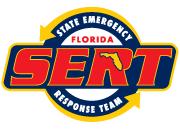Along the Atlantic Coast, from Nassau through Martin County, ocean swells from Tropical Storm Leslie are generating a high risk of rip currents. The risk of rip currents will also increase along the Southeast Florida coast, from Palm Beach County through Miami-Dade County later this week.
Additionally, an area of low pressure moving southward into the northern Gulf of Mexico will generate rough surf and large breaking waves up to 3-6 feet. The Emerald Coast, from Escambia through Gulf County, will see a moderate to high risk of rip currents through the end of the week.
“Ocean swells from distant Tropical Storm Leslie as well as an area of low pressure in the northern Gulf of Mexico bring a moderate to high rip current risk to some of Florida beaches, which will likely persist through the upcoming weekend,” said FDEM Deputy State Meteorologist Michelle Palmer. “Beachgoers should remember to review the rip current outlook for their area, check the warning flag signs before entering the water and swim within sight of a lifeguard.”
It is important to remember that when red flags are flying, beachgoers should remain alert while visiting Florida’s beaches. A rip current is a narrow, powerful current of water that runs perpendicular to the beach, out into the ocean. These currents may extend 200 to 2,500 feet (61 to 762 meters) in length, but are typically less than 30 feet (9 meters) wide. Rip currents can often move at more than 5 miles per hour (8 kilometers per hour) and are not always identifiable to the average beachgoer.
When at the beach:
- Before you leave for the beach, check the latest National Weather Service forecast for local beach conditions. Many offices issue a Surf Zone Forecast.
- Obey all instructions and orders from lifeguards. Lifeguards are trained to identify hazards.
-
Know the meaning of and obey warnings represented by colored beach flags.
Different beaches may use different colors but a commonly used series include:- Double Red: Beach is closed to the public
- Single Red: high hazard, e.g., strong surf or currents
- Yellow: medium hazard
- Green: Calm conditions although caution is still necessary
- Purple: Flown with either Red or Yellow: Dangerous marine life
- Stay at least 100 feet away from piers and jetties. Permanent rip currents often exist alongside these structures.
- Pay especially close attention to children and persons who are elderly when at the beach. Even in shallow water, wave action can cause loss of footing.
- Be cautious. Always assume rip currents are present even if you don’t see them.
- DON’T PANIC. Remain calm to conserve energy and think clearly.
- NEVER swim against the rip. Stay afloat and signal for help.
- Swim out of the current in a direction following the shoreline. When out of the current, swim at an angle--away from the current--towards shore.
- If you are unable to swim out of the rip current, float or calmly tread water.
- Draw attention to yourself: face the shore, wave your arms, and yell for help.
- Get help from a lifeguard or, if one is unavailable, have someone call 9-1-1.
- Throw the rip current victim something that floats--a lifejacket, a cooler, an inflatable ball.
- Yell instructions on how to escape.
###

No comments:
Post a Comment